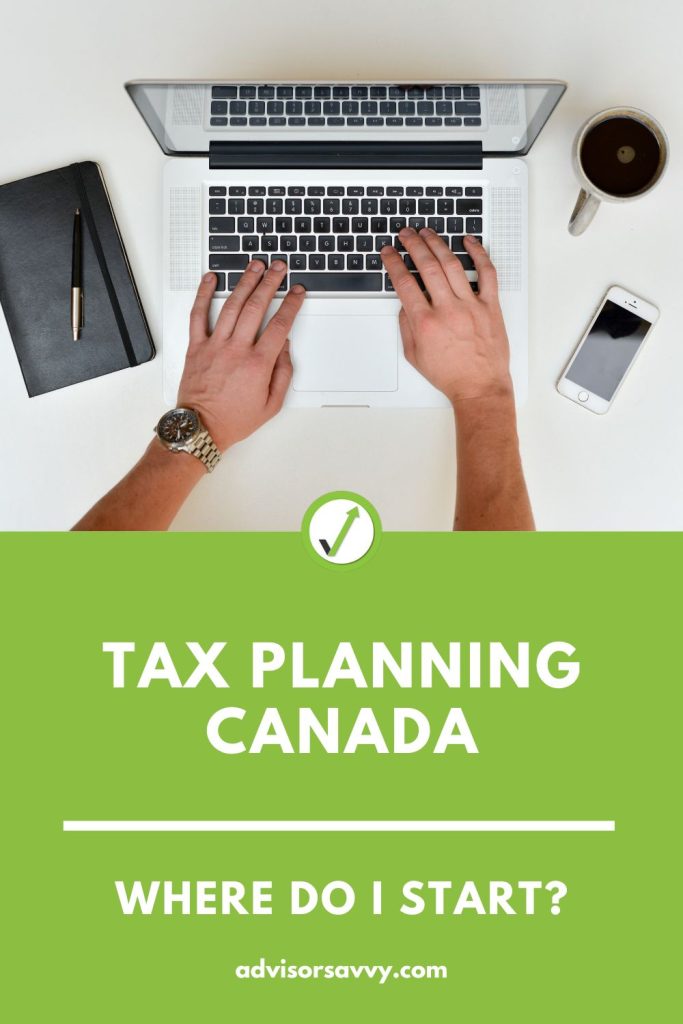
Tax planning in Canada is the personalized system you use to reduce the amount of taxes you are required to pay. In other words, it can help you maximize your yearly tax refund or reduce your annual tax liability. There are a few different methods used for tax planning in Canada. For beginners, it can be challenging to know where to start though. Plus, there are more complex tax planning strategies you can utilize when you have a better idea of your finances and taxes. More specifically, when you look at the law that governs the tax system in Canada. Your unique financial situation is best approached individually. Continue reading to understand where to start with tax planning and how to employ a personalized strategy this tax season!

Table of contents
What is tax planning in Canada?
Tax planning in Canada involves organizing your personal finances in a way that reduces the total tax you pay. This is not something that can be done last minute at the end of the year. It requires planning and continuous action. In other words, it’s a series of processes and procedures you employ into your personal finances to minimize taxes. With tax planning in Canada, you can effectively reduce the total amount of tax you pay each year or optimize your tax refund.
CIBC Investor’s Line Offer
Up to $6.95 per online stock or ETF trade. Plus, there’s no minimum account balance.
Is tax planning legal in Canada?
Tax planning in Canada is completely legal. Where Canadians need to be careful is with tax avoidance because you may violate general tax avoidance regulations. In addition, tax evasion is completely illegal in Canada, be sure to report honestly on your tax return!
Canada’s taxes are governed by the Income Tax Act (ITA). The Canada Revenue Agency (CRA) is responsible for administrating the ITA. The ITA has rules and regulations which inform what taxable income is, what is deductible and how to arrive at your total tax refund or liability. It defines tax rates based on different income levels and regions. Penalties and fines are included for entities that fail to follow the ITA or meet deadlines. These can result from reporting and payment errors, either accidental or intentional. Lastly, the ITA is designed to include incentives. These incentives provide tax credits and deductions, such as for charity, raising children, and so on.
Accountants, financial advisors and other similar professionals have long taken advantage of the ITA framework. There is potential to find legal “loopholes” for increased deductions and playing the tax system to your favor. This is highly complex and can enter the territory of aggressive or abusive tax planning, which can be flagged by the CRA. However, tax planning is often conservative and reasonable meaning that most Canadians don’t violate any legal regulations. Ultimately, the objective of tax planning is to optimize your taxes while following the rules outlined in the ITA.
Is tax avoidance a crime in Canada?
Tax avoidance is an aggressive form of tax planning whereby a person attempts to avoid payment of certain taxes. The main distinction between tax planning and tax avoidance is that the latter often sidesteps the law and may result in legal trouble. Tax avoidance isn’t illegal or a crime per se, but it can be a slippery slope. As taxpayers become more aggressive with their tax planning, they may push the ITA rules too far, thereby breaking the law.
There are certain situations in which interpretation is required. Tax avoidance occurs when this interpretation falls outside the intended “spirit” of the law. Tax avoidance takes tax planning and attempts to take advantage of the ITA to an excessive degree. The strategy employed in tax avoidance follows the written laws. However, it abuses the intended purpose or interpretation of the laws. This is not strictly a crime in Canada, but it could incur penalties, interest, and back taxes.
On the other hand, tax evasion has criminal consequences. Tax evasion involves deliberately ignoring regulations within the ITA in an attempt to intentionally withhold financial information. An example of tax evasion would be not reporting income earned in cash on your tax return to evade paying taxes on the earnings.
How to do tax planning in Canada?
To take advantage of tax planning in Canada, you should seek the support of a financial advisor. There are some key tax planning strategies available to everyone on a basic level. But your financial circumstances will determine more specific and customized strategies unique to you. A well-thought-out tax plan should be created well in advance of the upcoming tax year, which a financial advisor can help you design and implement. Although, it’s not too late for the 2024 tax season to start thinking about these things!
Take Advantage of RRSPs, TFSAs, RESPs
One of the easiest ways to make an effective tax plan in Canada is to take advantage of Registered Retirement Savings Plans (RRSPs), Registered Education Savings Plans (RESPs), and Tax-Free Savings Accounts (TFSAs). These accounts have powerful tax benefits that regular savings accounts don’t have. For instance, the RRSP tax deduction and tax-sheltered investment income. Let’s take a closer look at each below.
CIBC Investor’s Line Offer
Up to $6.95 per online stock or ETF trade. Plus, there’s no minimum account balance.
Registered Retirement Savings Plans (RRSPs)
Contributions to an RRSP lower your taxable income. Typically, Canadians can contribute up to 18% of their previous yearly income to an RRSP. The maximum amount contributable is up to $30,780 for the 2023 tax year, but this amount changes annually. Money in an RRSP grows tax-free until the money is withdrawn. RRSPs are designed for retirement savings, as the name implies. There are tax-efficient withdrawal strategies to consider when you enter your retirement years.
Registered Education Savings Plans (RESP)
RESPs allow you to save toward a child’s post-secondary education. The RESP grows through interest over time. Not only is it a smart investment in your child’s future, but it allows for tax savings. The RESP grows and tax is deferred until withdrawal, in the name of the recipient. Typically this person falls into a significantly lower tax bracket.
The federal government in Canada also offers additional incentives. Through the Canada Education Savings Grant, they can match 20% of RESP contributions. This is up to $2,500 per year or a lifetime maximum of $7,200 per child. You will have to pay taxes on your initial contribution. However, the grants and investment growth remain tax-deferred, plus free money!
Tax-Free Savings Accounts (TFSA)
TFSA accounts offer a place for money to be stored for general savings and investing. Money contributed to this type of account can grow tax-free. Meaning, if you invest from a TFSA account, any interest or dividends are earned tax-free.
For the 2023 year, you are allowed to contribute up to $6,500. You can also contribute any unused amount from previous years. Money in a TFSA account is not tax-deductible. However, their contributions earn investment income, tax-free. Finally, you can withdraw money from a TFSA without penalty.
Take Advantage of Employer Matching Programs
Many employers offer RRSP or other pension plan matching programs. They can also offer group RRSPs. Taking advantage of these programs increases the amount placed into your RRSP or pension. The employer contribution to your RRSP or group RRSP is tax deductible as well.
Income Splitting with a Spouse
If there is a significant difference in income between spouses or common law partners, you can split the income. The better-paid partner would transfer some of their income to the lower-earning partner. This results in less overall paid taxes within the household. There are some complexities to income splitting to consider, be sure to consult a professional if you need assistance.
Principal Residence Tax Exemption
This is a tax exemption available upon the sale of a property that was a principal residence. It can save significant amounts of money on capital gains taxes. However, with principal residence tax exemptions, you can avoid significant tax. This is something individuals typically consider at retirement, or during significant life transitions.
If you only have one property you own and reside in, then this exemption is pretty straight forward. But if you have multiple properties that you live between, then it becomes more complex and tax planning is required to take advantage of this exemption.
Charitable Donations
If you have a cause you feel strongly about, donate! The governments want you to donate money or investments and motivates you to do so through tax credits. Doing so can entitle you to significant tax savings. While charitable donations of investments can be complex, they often help avoid capital gains taxes. Oftentimes, this results in better value than the sale of investments and donating proceeds.
How do I reduce my income tax in Canada?
Below are some specific tax planning tactics in Canada specifically for reducing your income tax. These can be used in conjunction with the above.
1. Have all your purchase and sale records handy
Financial record keeping is not a fun task. However, documenting receipts as you get them will keep you organized and allow you to apply for all kinds of credits and deductions easily. Also, if you work alongside a finance and tax professional, it will make their job easier too.

Match to your perfect advisor now.
Getting started is easy, fast and free.
2. File taxes on time
Make sure you file your taxes on time. Failure to do so can result in penalties. If you’re expecting a refund, try to file earlier than the deadline so you can get your money back faster.
Related Reading: How to Set Yourself Up for Financial Success
3. Think about tax impacts daily
It can take a while to understand the tax environment in Canada. But, the more you educate yourself, the more you can think about it in your day to day financial life. This way, you won’t be scrambling at tax time.
What are some tax loopholes in Canada?
Most tax loopholes in Canada are the result of aggressive tax planning which can enter tax avoidance strategies. The ITA can be used and interpreted in many ways. The ITA should always be followed with the intention the laws were written. While some loopholes can be pursued at the advisement of tax professionals, it is best to stay clear. There are known tax planning techniques to reduce overall taxes. These techniques include RRSPs, TFSAs, RESPs, spousal tax splitting, and charitable donations. These techniques can afford huge tax savings. For more intricate tax planning techniques always consult professionals.
Related Reading: Self Employed Tax Deductions Canada
Tax Planning in Canada for the 2024 Tax Season
There is still a significant amount of time to begin tax planning in Canada for the 2024 tax season. Some simple but effective strategies can be used, even if you begin now. Everyone’s circumstances are different. Tax professionals and financial advisors can be very helpful. They will help create your unique tax plan. Once a tax planning strategy is created, each year you will have the opportunity to update it. You will be able to make the appropriate modifications each year.

Match to your perfect advisor now.
Getting started is easy, fast and free.

